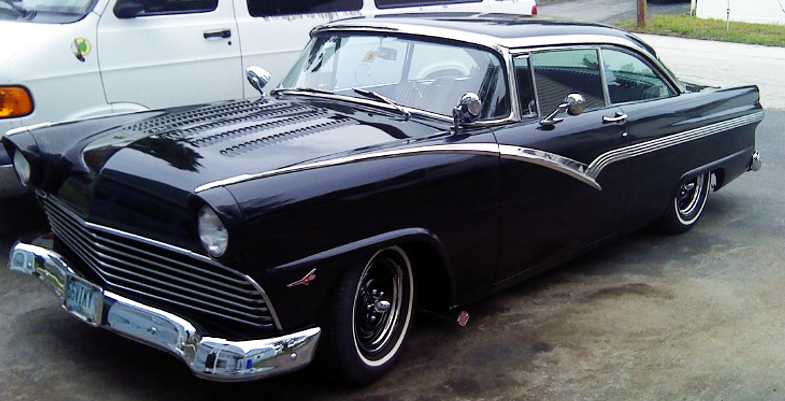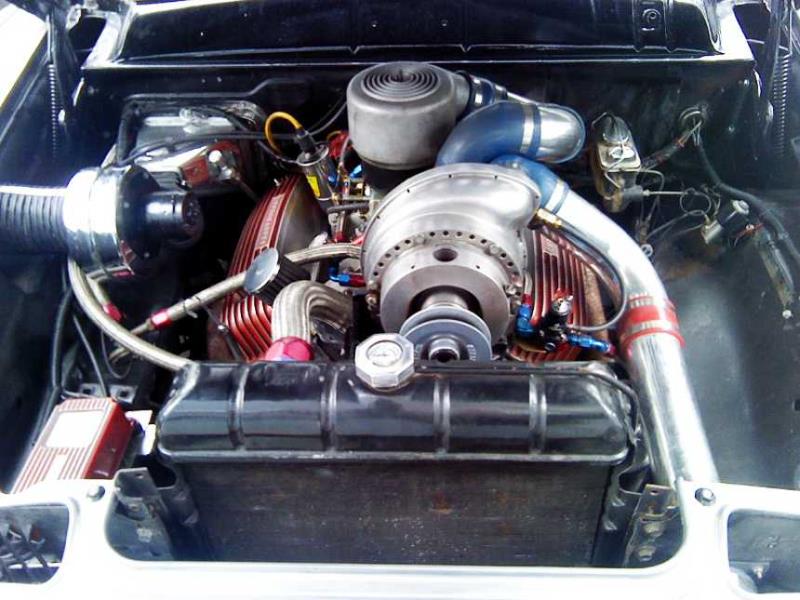|
Author
|
Message
|
|
ian57tbird
|
|
|
Group: Forum Members
Last Active: 2 Weeks Ago
Posts: 498,
Visits: 21.7K
|
At one time I was regularly checking mileage on mine. 3.1 rear, G78x14 tyres, auto, stock 312, I would always get a combined of around 16-17Imp mpg = about 13.5-14US mpg.
Could possibly do better, as I'm will put my foot into it on occasions, and I don't drive slowly.
|
|
|
|
|
55blacktie
|
|
|
Group: Forum Members
Last Active: 2 days ago
Posts: 1.2K,
Visits: 1.8K
|
Drylakesracer, there's a lesson to be learned, here: Keep moving! You'll get better mpg, and your car won't overheat. It might be easier, if I move from California.
|
|
|
|
|
paul2748
|
|
|
Group: Forum Members
Last Active: Yesterday
Posts: 3.6K,
Visits: 497.7K
|
The last trip I made coast to coast in my 56 Bird, I got an average of 14 MPG. This was all kinds of driving - flat plains, high mountains, city and country. 6300 miles total. 312 with a C-4, stock rear
54 Victoria 312; 48 Ford Conv 302, 56 Bird 312
Forever Ford
Midland Park, NJ
|
|
|
|
|
MoonShadow
|
|
|
Group: Forum Members
Last Active: Yesterday
Posts: 4.6K,
Visits: 38.3K
|
When my van broke down I drove my 56 Vicky, 325 cubic inch, 4-71 blown y-block from Cincinnati to New Hampshire. I do have an AOD overdrive transmission and I think around a 3:80 rear gear. I averaged a high 17mpg with steady highway driving around 70. I was a bit shocked by it.
Y's guys rule!
Looking for McCullouch VS57 brackets and parts. Also looking for 28 Chrysler series 72 parts. And early Hemi parts.
 
MoonShadow, 292 w/McCulloch, 28 Chrysler Roadster, 354 Hemi)
Manchester, New Hampshire
|
|
|
|
|
55blacktie
|
|
|
Group: Forum Members
Last Active: 2 days ago
Posts: 1.2K,
Visits: 1.8K
|
Thanks to all. I will recommend that the members of the T-bird forum read these posts.
|
|
|
|
|
PF Arcand
|
|
|
Group: Forum Members
Last Active: Last Year
Posts: 3.3K,
Visits: 238.8K
|
The issues with the "Loadomatic", pre 1957 distributors, which don't have centrifical advance has plagued Y-block engine owners for years.. Because, if using a 1957 & later Carb with that vacuum only distributor, the setup will not work properly. Nor will an original stock Holley 4000 'teapot" work properly as is, with the 1957 & later Distributors. For proper info on that later issue," Link" from this site to "Ted Eaton's Balancing" site & scroll down to his instructive article on modifying the Holley Teapot carb to work with the 1957 & up distributor..
Paul
|
|
|
|
|
Tedster
|
|
|
Group: Forum Members
Last Active: 3 Years Ago
Posts: 513,
Visits: 153.3K
|
PF Arcand (6/2/2021)
Nor will an original stock Holley 4000 'teapot" work properly as is, with the 1957 & later Distributors. & up distributor.. The "Teapot" carburetor doesn't care what distributor is used, although it is true there is no source of ported vacuum below the throttle plates. That's what the carburetor modification is about. But manifold vacuum (from whatever source derived) can be made to work perfectly well with a dual distributor, I wouldn't let the carburetor be a show stopper when considering whether to ditch the LoadOmatic. Achieving a perfectly steady idle RPM can sometimes be an issue (which incidentally was why the "ported" type of vacuum signal was invented).
|
|
|
|
|
Ted
|
|
|
Group: Administrators
Last Active: 6 days ago
Posts: 7.5K,
Visits: 205.8K
|
My two cents worth. Like most engines, the Y likes an overdrive transmission. Allowing the engine to run steady state at 3000 rpm versus 2200 rpm puts any engine at a definite disadvantage for any bragging rights fuel mileage numbers. The lack of overdrive puts the early Ford-O-Matic trannies equipped vehicles at a disadvantage when comparing the fuel mileage to a car or Thunderbird equipped with overdrive. To compound the fuel mileage issue with the older engines is the addition of ethanol into the gasoline which forces the need to increase the volume of fuel going into an engine to maintain the ideal fuel/air ratio. Going too lean on fuel mixtures can have the engines actually using more fuel as they then have to be driven deeper into the throttle just to maintain a given speed. The Holley Teapot carbs are sensitive to the addition of ethanol to the gasoline and many require an increase in the primary jet size to compensate for a lean condition that creates a hesitation issue. Another issue that crops up for the fuel mileage is the second ring wear. The second ring in many instances is a tapered ring and as it wears, the ring drag against the cylinder wall is increased. Up to 40K miles, that piston drag is much lower than what you will find with the same rings reaching the 100K mile and more mark. As the friction within the engine increases, the necessary fuel required to overcome this must also increase. Reduce the friction and you will reduce the fuel requirements. My ’55 has almost 200K miles now since having new pistons and piston rings installed in 1989 and the fuel mileage now with what I’ll call local driving is now averaging 15-16 mpg. Back in its heyday, I did see 21 mpg on occasion when highway driving but 19mpg was more the norm for any trip mileage. That car has a BW 30% overdrive tranny with 3.56 rear gears while the 272 engine does have an Isky E4 camshaft and now with a Summit 500 cfm 4V carb. Looking back at my fuel mileage records, that car still averaged 13.6-15.7 mpg during the weekend I raced the car at the Big Bend Open Road Race. At that time, the car had a Speed Demon Jr. 525 cfm carb. That race is 118 miles long and the car was entered in the 90 mph class with speeds up to 110 mph being recorded when needing to make up time for curves, hills, and other impediments to maintaining a 90 mph average. And then there was also parade duty which also didn’t help the fuel mileage. It should go without saying that the condition of the engine and its tune up is paramount in getting ‘good’ fuel mileage. Keep those comments coming.
  Lorena, Texas (South of Waco) Lorena, Texas (South of Waco)
|
|
|
|
|
tbirddragracer
|
|
|
Group: Forum Members
Last Active: 5 Months Ago
Posts: 56,
Visits: 95.8K
|
I have a "57 T-Bird " C " car with a 292 engine, 2 bbl. carb with a 3 speed standard transmission. I swapped in a 3 speed
overdrive transmission with a 3.10 rear gears. I did not make this swap for the mileage, but to reduce engine rpm's, so I
rarely checked mileage. On one trip from Tyler to Denver Colorado, a couple of mileage checks showed slightly
above 24 mpg. This was without driving for maximum mileage. A well tuned engine is essential for best results.
Ernie
|
|
|
|
|
55blacktie
|
|
|
Group: Forum Members
Last Active: 2 days ago
Posts: 1.2K,
Visits: 1.8K
|
My speedometer was about 15% fast, which seems to be common, original transmission and 3.31 gears, and 205/75R15 tires. On one hand, my car has fewer miles than indicated by odometer. On the other hand, gas mileage is worse than indicated. Hopefully, C4 transmission, 2.72 gears, and metric rings will show an improvement. Once the rebuilt engine is broken in, I might consider swapping carb for FiTech. The car will never be a daily driver, but might as well make it more efficient during restoration.
By the way, my 2015 Toyota Rav4 and 2017 Ram 1500 miss the mpg mark. There is a big difference in mpg between driving 65 on a flat highway/w little traffic, and driving around town, no matter what you drive. For what it's worth, I had a 1988 Mustang 5.0 convertible/w AOD and 2.73 gears. It was capable of over 25 mpg on the highway, and 18 mpg in town. I think Ford got it right with that one.
|
|
|
|